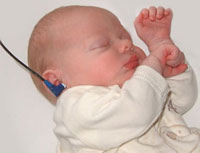File:Newborn hearing test.jpg
Newborn_hearing_test.jpg (200 × 153 pixels, file size: 6 KB, MIME type: image/jpeg)
The incidence of significant permanent hearing loss is approximately 1-3/1000 newborns. Neonatal hearing screening is carried out in the USA, UK and in Australia (2002 NSW Statewide Infant Screening Hearing Program, SWISH) There is a general guide giving a timetable for a number of simple responses that a neonate should make if hearing has developed normally (More? Neonatal Hearing Check List).
State Wide Infant Screening Hearing Program (SWISH) a newborn hearing testing program using an automated auditory response technology (AABR). Program was introduced in NSW Australia in 2002 across 17 area health service coordinators. It is thought that in NSW 86,000 births/year = 86-172 babies potentially born with significant permanent hearing loss.
Automated Auditory Brainstem Response (AABR) uses a stimulus which is delivered through earphones and detected by scalp electrodes. The test takes between 8 to 20 minutes and has a sensitivity 96-99%.
File history
Yi efo/eka'e gwa ebo wo le nyangagi wuncin ye kamina wunga tinya nan
| Gwalagizhi | Nyangagi | Dimensions | User | Comment | |
|---|---|---|---|---|---|
| current | 13:46, 23 April 2010 |  | 200 × 153 (6 KB) | S8600021 (talk | contribs) | The incidence of significant permanent hearing loss is approximately 1-3/1000 newborns. Neonatal hearing screening is carried out in the USA, UK and in Australia (2002 NSW Statewide Infant Screening Hearing Program, SWISH) There is a general guide giving |
You cannot overwrite this file.
File usage
The following 13 pages use this file:
- 2010 Foundations Lecture - Introduction to Human Development
- 2011 Lab 10 - Postnatal
- ANAT2341 Lab 10 - Postnatal
- Abnormal Development - Cleft Lip and Palate
- Abnormal Development - Thalidomide
- BGDB Face and Ear - Postnatal
- Foundations Lecture - Introduction to Human Development
- Hearing test
- K12 - Communication
- Neonatal Diagnosis
- Pre-Medicine Program - Embryology
- Sensory - Hearing Abnormalities
- Sensory - Hearing and Balance Development
